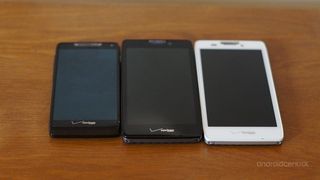Motorola DROID RAZR HD/MAXX HD review

When the original RAZR hit the market last summer, followed shortly after by the RAZR MAXX, a lot of people were eagerly awaiting a true flagship line from Motorola. And the devices were met with success, thanks to Verizon's aggressive marketing and the MAXX's considerable battery advantage.
Shortly after its release, though, the RAZR was outspec'd and overshadowed, relegating it to mid-tier status behind the likes of HTC's One line and Samsung's Galaxy S 3. But good things come to those who wait, and fortunately, Motorola seems to have been hard at work over the past few months. Today, the RAZR HD and MAXX HD are equipped to reclaim their spot on Verizon's top shelf. But do they have the curb appeal to compete with some of the best Android devices ever made? Find out in our full review of the Motorola RAZR HD and RAZR MAXX HD. For another perspective, be sure to check out our earlier review of the Canadian version.
Pros
- The RAZR HD and MAXX HD both offer stunning displays, eye-catching design, and top-notch performance. The UI is as close to pure Android as you'll get outside of a Nexus, and Jelly Bean is said to be right around the corner. The RAZR HD's battery life is simply astounding, and the MAXX HD's longevity will leave you in awe.
Cons
- On paper the RAZR HD and MAXX HD are similar in size to competing phones, but in the hand they feel much more dense and thick. Motorola's optics are dated and stale, and the results are subpar photos and video.
The Bottom Line
| Hardware reviewSoftware reviewCamera testsWrap-up | Droid RAZR HD/MAXX HD specsDroid RAZR HD/ MAXX HD forums |
The one-take walkthrough
Droid RAZR HD Hardware
I've said it before in my Droid RAZR M review and I'll say it again here -- Motorola is making some of the best hardware on the smartphone market today. Period. The company seems to have made a concerted effort over the past year to focus its efforts on quality materials and streamlined, across-the-board design language, and the RAZR HD line is the pitch-perfect fruit of its labor.
There is no mistaking the RAZR HD for anything other than a Motorola device -- the metallic trim, Kevlar back, and ever-so-slightly rounded edges are exactly what we fell in love with on the original RAZR, now in a larger package. This is a premium design, definitely a step up from Samsung's current strategy and right in line with the likes of the iPhone and HTC's One series.
Be an expert in 5 minutes
Get the latest news from Android Central, your trusted companion in the world of Android
While it retains most of the original RAZR's looks and feel, there is definitely a noticeable difference, particularly in terms of size. The revamped RAZRs are noticeably thicker and denser than the originals, but that's mostly a good thing. Rather than the slim-then-protruding profile of last year's RAZR, Motorola went for a more even, uniform design, eliminating the trademark Moto-bump and opting for a thicker girth with a barely noticeable increase towards the top. The RAZR HD is 0.33 inches thick and weighs in at 141 grams, while the MAXX HD is slightly chunkier at 0.37 inches and 157 grams. While those dimensions fall in line with the likes of the Optimus G and the Galaxy S 3, the RAZRs do appear much thicker at first glance, most likely due to their glass-atop-metal-atop-Kevlar design. The same can be said about their weight -- it's not all that heavier than the rest of the pack, but there's a density here that is really hard to ignore. Regardless, these phones fit perfectly in hand.

The volume rocker and power button are located on the right side, while the HDMI and microUSB slots are found on the left. The left side also houses a microSIM and microSD card tray, accessible using Motorola's included SIM tool or a thin paperclip. The backside of the RAZR is finished with a Kevlar coating that is neither slippery nor smudge-prone. Like the original RAZRs, the battery is non-removable, so don't strain yourself looking for a removable door.
The notification light has taken up residence between the Motorola logo and earpiece on the front of the phone -- it's wide, bright, and cleverly placed.




The RAZR HD's display is the most noticeable and impressive upgrade from the original RAZRs. It's big and beautiful at 4.7-inches, packing a 1280x720 resolution (312 ppi) with Super AMOLED technology. It's covered with Gorilla Glass and splash-proof nanocoating, and lacks capacitive buttons, opting for on-display navigation the way Google intended. The result is something truly special. This is the display that the RAZR line always deserved -- it's crisp, colorful, vibrant, and sharp. Because of its Pentile matrix it does appear a bit less sharp as the IPS displays that LG and others are shipping, but that's a very high bar. The RAZR is noticeably brighter than the Galaxy S3, and performs admirably in direct sunlight unlike some of its competition. Simply put, this is the greatest display Motorola has ever shipped.

The RAZR HD is beautiful on the inside too, with its 1.5GHz dual-core Snapdragon S4 processor, 1 GB of RAM, and 16 and 32 GB storage options. Coupled with a nearly vanilla Android experience (more on that later), these devices scream. You've got as much horsepower as the One X and the Galaxy S3, so there's no speed compromise to be made. Things are fast and fluid here, noticeably more so than the original RAZRs. While it doesn't meet the blistering speeds of the Optimus G or the Galaxy Note 2, the RAZR HD can handle just about anything you throw at it.

Also underneath the hood is the RAZR's battery, the one and only differentiation between the RAZR HD and RAZR MAXX HD. The RAZR HD packs 2,530 mAH, while the MAXX HD boasts a whopping 3,300 mAh. Here's the kicker -- whichever model you choose will give you hours on hours of usage. Even the plain old RAZR HD runs circles around the competition in terms of battery life, easily getting you through 24 hours of moderate usage. The MAXX HD ups the ante even more, and as hard as it is to believe, I managed to get 36 hours of a single charge. And this is without using Smart Actions to squeeze out every last bit of juice. If I took a minute to truly optimize the device for battery life -- which Motorola's SmartActions make very simple to do -- I have no doubt that I could push that up to 48 hours. Forget playback tests, forget silly HD video-on-loops in a lab. These are real-life numbers, and they're unmatched by the competition. Prepare to be spoiled.

Droid RAZR HD Software

There's really not much to say about the RAZR HD line's software, and trust me, that's a good thing. Motorola has chosen to stay as close to vanilla Android as possible, while keeping Verizon happy with its usual laundry list of bloatware. The RAZRs ship with Ice Cream Sandwich, though Moto says Jelly Bean is right around the corner. Based on the recent leak for the Droid RAZR M, I'll chose to believe this promise. There is slight skinning here and there, like in the settings menu and lock screen, but for the most part you're going to recognize Android as it was intended. And the minor tweaks that Motorola has made are welcome and useful. Swipe to the left of the home screen for a list of "Quick settings" and to the right to "Add a page" are super intuitive, eliminating some unnecessary steps. As I said in my RAZR M review, this does change the dynamic of home screens, turning the panel furthest to the left rather than the center into your default "home."
What differs from the RAZR M, though, is the bloatware included on the devices. Both the M and the HD come with their fair share of preinstalled apps, but they are not identical. For example, Verizon and Motorola chose to include the full suite of Amazon apps on the M, while the RAZR HD is missing Amazon MP3 and the Amazon Appstore. I'm curious to find out what drove this decision.

The only real Motorola-branded app of note here is Smart Actions, which I praised on the RAZR M, and will praise again here. It's feature-rich and easy to use, and though it does require time and patience, it's worth every second you spend on it. You can tell your RAZR HD how to act based on location, time, and condition, and the results can be as intuitive or as simple as you'd like. As I said before, the MAXX HD's battery life is practically limitless when coupled with some quality time spent in Smart Actions.
The Motorola Droid RAZR HD cameras

With so much time invested in such solid hardware and stellar battery life, it's disappointing to see that Motorola skimped on the cameras. This 8 MP shooter is largely unchanged from what we've already seen from Motorola, and these optics are in dire need of a refresh. The results aren't terrible, and in fact, when paired with optimal lighting and a steady hand, photos can come out quite well. But when compared with the eye-popping shots you'll get from HTC and Samsung's latest, the RAZR HD's images will look immediately out of date.








The bottom line

The RAZR HD and MAXX HD, along with last month's RAZR M, add up to one of the most recognizable lines in the mobile industry and put Motorola back in the ring with the current Android heavyweights. This refresh is much deserved and checks off nearly everything on our wishlist: super-fast processor, mind-boggling battery life, and a top-of-the-line display. Sure, the camera could be better, and many will find the RAZR line significantly less sexy and slim than the Galaxy S3 and One X, but as a total package, the RAZR HD and MAXX HD are two of the best phones you could have the pleasure of using.
I don't understand why Motorola chose to keep the RAZR HD while alongside the MAXX HD as the standard, especially considering how similar the two are in both size and functionality. That said, Motorola does indeed make an extra $100 on the MAXX HD, which is priced at $299 compared to the RAZR HD's $199, so I guess you can't blame a dog for barking. For most, the RAZR HD will provide ample battery life for normal to heavy-usage, but for those glued to their smartphones, the MAXX HD is worth every penny. Whether or not you drop an extra $100 is up to you, but rest assured, whichever decision you make, you won't come away disappointed.














































